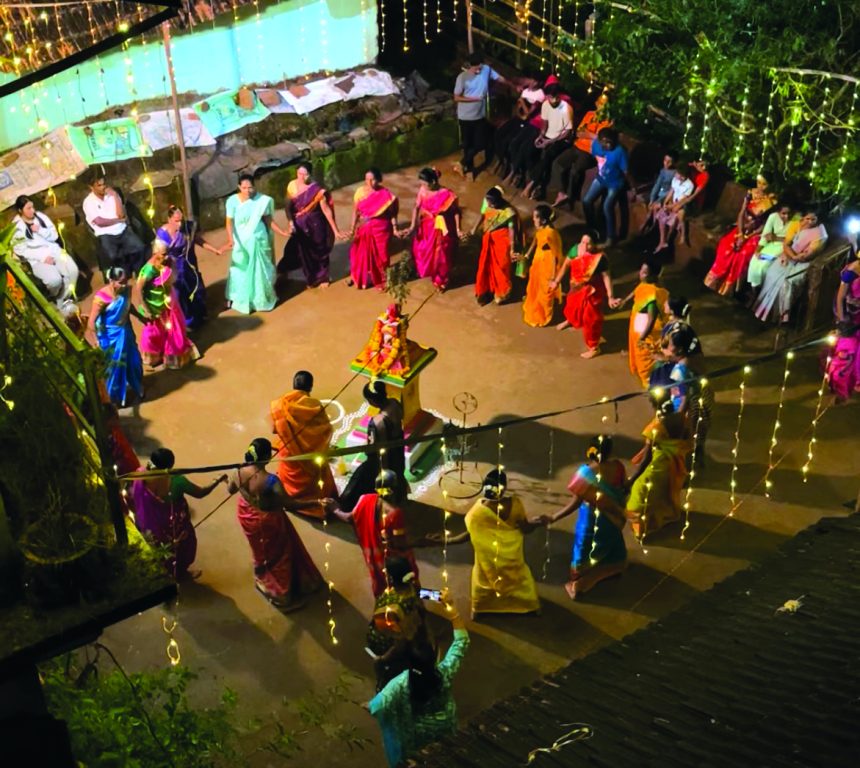SAMRUDHDI KERKAR
On the serene full moon night of Kartik Pournima, cutting through the dark, dense forest, our vehicle finally reached a beautiful village named Sacorda Udalshe in Dharbandora. Snuggled cosily beneath a blanket of verdant trees, this little village rests on the right bank of the Ragado River, embraced by the forested arms of the Mahaveer Wildlife Sanctuary.
We had come to witness the Kaatyo festival, also known as the celebration of constellations. The night was quiet, yet the air felt alive, filled with the hush of soft murmurs and the gentle glow of Diwali lamps flickering through courtyards.
We walked toward the ‘maand’, the sacred space where the festival was to unfold. It was a wide, open front yard of Ganpat Kalekar’s house. To the left of their Tulsi Vrindavan, the ground had been neatly plastered with cow dung, and over it lay a delicate rangoli made of rice flour, depicting a crescent moon with a tiny dot at its heart, and seven stars.
When we asked Ganpat baba about its meaning, he explained that it represented the Krittika constellation: the cluster of seven stars, the crescent moon, and a small sun within the vast sky.
We were enchanted by the thought, yet one question arose, why a sun at night?
He said, “Though the sun is waning now and the moon has appeared, the day will rise with the sun again tomorrow.” His words carried a wisdom that left us deeply moved at such simple yet profound thoughtfulness.
As the moon climbed higher, one by one, women from the village began to gather, draped in colourful sarees and ‘kapad’. Soon women of all ages: curious young girls, cheerful women in conversation, and graceful elders whose faces glowed in the moonlight, joined hands, forming a wide circle around the Tulsi Vrindavan, and sang in unison: “Kaatyo baaye kaatyo… Akashi udhyalo chandrima udyalo katiyo…Kaatiyo udyalo akashilyo, rama rovlyo bhair sarilyo shringarilyo kaatyo” (Kaatyo – the Kartik month or the Krittika constellation has arisen in the sky. The women have gathered, adorned in their finery, just as the stars of the constellation shine above.)
Krittika, the third nakshatra in Vedic astrology, is associated with Agni, the God of Fire. Villagers with deep agrarian roots narrate a fascinating story behind this festival. It is said that during this time of the year, when the crops were ready for harvest, they would often catch fire. To prevent this misfortune, villagers symbolically bring the Krittika constellation down to earth and offer prayers to protect their fields.
This ritual speaks volumes about the wisdom and observation these people have always held of nature and the constellations. The sky was like their calendar and their clock. It’s truly amazing how they could tell which constellation would bring the rain, and which one would herald the cold. The entire scene looks spectacular. As the moon rises in the middle, everything appears circular, the moon, the constellation, the rangoli, and the ring of women around it. It feels as though the same constellation has descended to earth, dancing in all its colours. The dance goes on till past midnight, or till the constellation can be seen clearly in the sky. Their songs often mention deities like Payak, Jalmi, Khapro, and Vagro, all deeply rooted in nature. These forest gods reflect the bond these people share with their surroundings, the nature and sacred spaces found at every nook and cranny of the village.
The festival of Kaatyo is celebrated only in Udalshe and Okambi villages of Dharbandora Taluka, and in Pazwada of Ponda Taluka. It is mainly observed by the Gawda community. In Udalshe, the festival continues for four days, beginning with Tulsi Vivah and culminating on the night of the full moon.
On the final day, a woman from the gaonkar’s family (village headmen), observes a strict fast for 24 hours, sipping only coconut water. The ‘prasad’ includes humble, earthy foods like ‘paayas’ (rice porridge), ‘kanaga’ (tuber), ‘karane’ (air potato), and ‘pole’ (traditional rice pancake), all prepared without salt. The offerings are then shared among everyone but never taken home.
It was delightful to witness this joyful custom. When the rituals finally ended, the fasting woman broke her fast with a simple meal of mackerel curry, but again, without salt.
We were all left overwhelmed after witnessing the Kaatyo. If observed closely, the wisdom and devotion that our folklore, traditions, and festivities hold towards nature and their understanding of divinity, are truly fascinating. It is this culture that makes our land rich, humble, and deeply rooted. If we try to study and preserve these practices, our land will continue to bloom more colourful and alive than ever.



